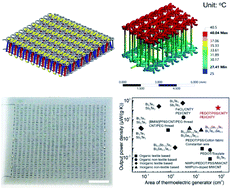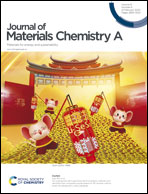Carbon nanotube yarn based thermoelectric textiles for harvesting thermal energy and powering electronics†
Abstract
Wearable thermoelectric devices show promise to generate electricity in a ubiquitous, unintermittent and noiseless way for on-body applications. Three-dimensional thermoelectric textiles (TETs) outperform other types in smart textiles owing to their out-of-plane thermoelectric generation and good structural conformability with fabrics. Yet, there has been a lack of efficient strategies in scalable manufacture of TETs for sustainably powering electronics. Here, we fabricate organic spacer fabric shaped TETs by sewing carbon nanotube yarn based segmented thermoelectric textiles on a large scale. Combining finite element analysis with experimental evaluation, we elucidate that the fabric structure significantly influences the power generation. The optimally designed TET with good wearability and stability shows a high output power density of 51.5 mW m−2 and a high specific power of 171.7 μW (g K)−1 at ΔT = 47.5 K. The promising on-body application of the TET in directly and continuously powering electronics for healthcare and environmental monitoring is fully demonstrated. This work will broaden the research vision and provide new routines for developing high-performance and large-scale TETs toward practical applications.

- This article is part of the themed collection: Journal of Materials Chemistry A HOT Papers


 Please wait while we load your content...
Please wait while we load your content...